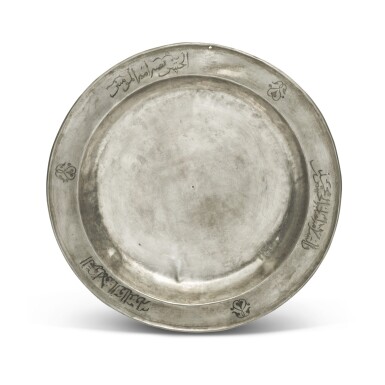
A nielloed silver dish with inscription, Persia or Central Asia, 11th/12th century
Auction Closed
March 30, 12:47 PM GMT
Estimate
30,000 - 50,000 GBP
Lot Details
Description
of rounded shape with a flat base, the everted flat rim with three nielloed inscriptions interspersed by a palmette
29cm. diam.
G. Livont, 1974-2005.
Professor Alexander Livontas (1920-74), Lithuania, 1950s.
By repute, ex-collection Seraya Szapszal, Lithuania, 1st half 20th century.
inscriptions
‘Glory and prosperity and wealth and well-being to its owner al-Husayn ibn Muhammad al-Hasan, helper of the Commander of the Faithful’
The same name al-Husayn ibn al-Hasan ibn ‘Ali, (…) helper of al-Nasir Commander of the Faithful, is recorded on an inscription over the door of a mausoleum in Uzgend dated 1152.
The arch above the door of the mausoleum is decorated with thee niches filled with palmettes, the central one resembles in shape the ones found on the current dish. Another comparable for this motif is a tomb marker dated to the twelfth century. Densely carved with geometric bands, it bears two symmetrical palmettes close to those found on the present dish (Metropolitan Museum of Art, New York, inv. no.30.112.45).
In his discussion of a nielloed silver sprinkler and related silver plates Boris Marshak stated the following:
"From the mid-ninth century on, Near Eastern vessel shapes, floral arabesques, and Kufic inscriptions enriched the thesaurus of the East Iranian silversmiths, and all the old Sogdian decorative elements totally disappeared soon after AD 1000. The quasi-architectural composition of friezes and medallions set against a blank ground as well as the nielloed backgrounds of these decorative zones is attested from, probably, the late Samanid period."
Boris I. Marshak, ‘An Early Seljuq Silver Bottle from Siberia’, Muqarnas, vol.21, Essays in Honor of J.M. Rogers, Leiden, 2004, pp.262.
You May Also Like










